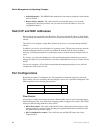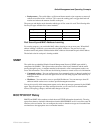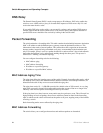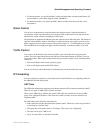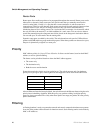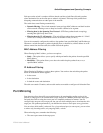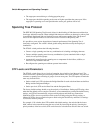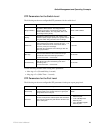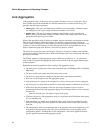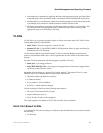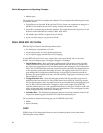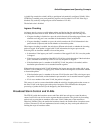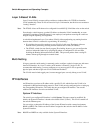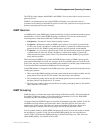30 ZT8101 User’s Manual
Switch Management and Operating Concepts
Link Aggregation
Link aggregation allows several ports to be grouped so that they can act as a single port. This is
done to either increase the bandwidth of a network connection or to ensure fault recovery. The
group has the following assignments:
• Master port—This port is the Ethernet port with the lowest port number. All member ports
are configured to use its port settings and become members of its VLAN.
• Anchor port—This port is in charge of sending control packets, such as spanning tree
BPDUs, and also the flooding of multicast frames. When a link change event occurs in the
group, the anchor port may be re-elected.
When a link aggregation group is deleted or disabled, the ports retain their reassigned port settings.
They do not recover their original port settings. For example, suppose that Port 1 belongs to
VLAN1 and Port 2 belongs to VLAN2. When you create a group with a starting point of Port 1 and
a width of 2, Port 2 will be added to VLAN1 and removed from VLAN2 automatically. If you
delete or disable the group later, the Port 2 will still be assigned to VLAN1.
The switch also assigns the group a anchor port. This port is in charge of sending control packets
and also the flooding of multicast frames. When a link change event occurs in the group, the anchor
port may be re-elected.
The ZT8101 supports six link aggregation groups, which may include from 2 — 8 switch ports
each, except for a gigabit link aggregation group, which consists of the two gigabit Ethernet ports
on the front panel.
Remember the following guidelines when creating a link aggregation group:
• The ports used in a group must all be of the same media type (10/100 Mbps fiber or 100/1000
Mbps fiber).
• The ports used for each group must all be on the same switch.
• The ports in a group must be contiguous (they must have sequential port numbers).
• Ports can only be assigned to one link aggregation group.
• None of the ports in a group can be configured as a mirror source port or a mirror target port.
• All of the ports in a group must be treated as a whole when added to or deleted from a VLAN.
• STP will use the port parameters of the base port in the calculation of port cost and in
determining the state of the link aggregation group. The following formula is used to calculate
the path cost:
path cost of master port - the number of ports in the group
• STP treats all ports in a link aggregation group as a single port and will block the entire group
if it is a redundant link.
• Data transmitted to a specific host (destination address) will always be transmitted over the
same port in the group. This allows packets in a data stream to arrive in the same order they
were sent.
• The configuration of the lowest numbered port in the group becomes the configuration for all
of the ports in the aggregation group. This port is called the base port of the group, and all
configuration options—including the VLAN configuration—that can be applied to the base
port are applied to the entire link aggregation group.



